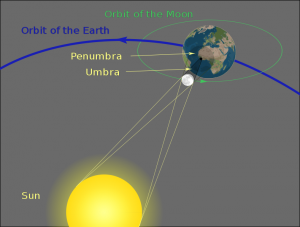On May 20, 2012, a swath of the midsection of the Western US (and also the Pacific Ocean and Asia) will experience an annular solar eclipse. At 10,600 feet above sea level, the Magdalena Ridge Observatory has one of the best astronomical seeing conditions of any observatory in the United States so, weather permitting, we should be able to enjoy one of the best views of the of the eclipse possible in the entire country.
Solar eclipses, whether total or annular, occur when the Moon passes directly between the Sun and the Earth casting its shadow on the Earth. Not all planets experience eclipses; the necessary ingredients include a moon in the right geometric position and a moon that is big enough so that it can cast a shadow on the planet from the star’s light. On Earth, solar eclipses always happen at the “New Moon” phase. But solar eclipses cannot happen at every “New Moon” phase because the Earth, Moon and Sun all have to be in the same plane and the separations must be in the right ratios for the sizes of the Sun and Moon to be well-matched. The changes in sizes occur because the Moon’s path around the Earth is elliptical rather than truly circular.
The deepest part of the shadow of the eclipse is called the umbra (from Latin for “shadow”), while the less dark part along the sides is the penumbra (“almost shadow”) and just past the umbra is the antumbra (“behind shadow”). If you are in the umbra path, you experience a total eclipse, while in a penumbra you see a partial eclipse. Many eclipses, however, occur in the antumbra, when the Moon is farther away from the Earth than during a total eclipse, so the umbra misses us.
It is these, an antumbral eclipses which are called annular eclipses. Annular eclipses typically last tens of minutes but can range around that by a factor of two. There are, on average, two solar eclipses per year but they can range from none to as many as five eclipses in any particular year. The last total solar eclipses in the US include one through the US and Mexico in July, 1991, one through the northern US and Canada in Feb, 1979, and one along the east coast of the US in March, 1970.

An annular eclipse diagram occurs when the Moon covers the center of the Sun but not its edges leaving a ring (annulus) of the Sun visible around the edges.
The Moon has always been an important celestial object for early civilizations as it was used primarily to tell time especially for planting, harvests and festivals. Many of today’s modern calendars are lunar in their origins and in fact the English word “Month” has the same root as the word “Moon” and refers to the 29.5 days of a lunar cycle. The ability to predict eclipses has been enjoyed by almost all civilizations which have an interest in the celestial objects and mathematics. The ability to predict solar eclipses has also been used by leaders of countries over time as an indication of connection with “the divine” and so legend and mysticism are sometimes combined with eclipses. The prediction of eclipses has been used to manipulate people, often as portends dangers to come.
Today, eclipses are frequently considered an event of historical interest and an opportunity for people to learn more about celestial bodies. Scientists use solar and other types of eclipses to test scientific theories and study atmospheres of the Sun (or in the case of other types of eclipses, other stars or planets). When an eclipse blocks out bright light from the sun or a star, just the edges of the light from the star can be seen. This light is used to study phenomena like coronal mass ejections and magnetic loops on the Sun and also the atmospheres of other stars.

Partial solar eclipse October 7, 2010 from space. Images courtesy of Solar Dynamic Observatory, NASA
For more information on the eclipse please visit the NASA Annular Solar Eclipse website


